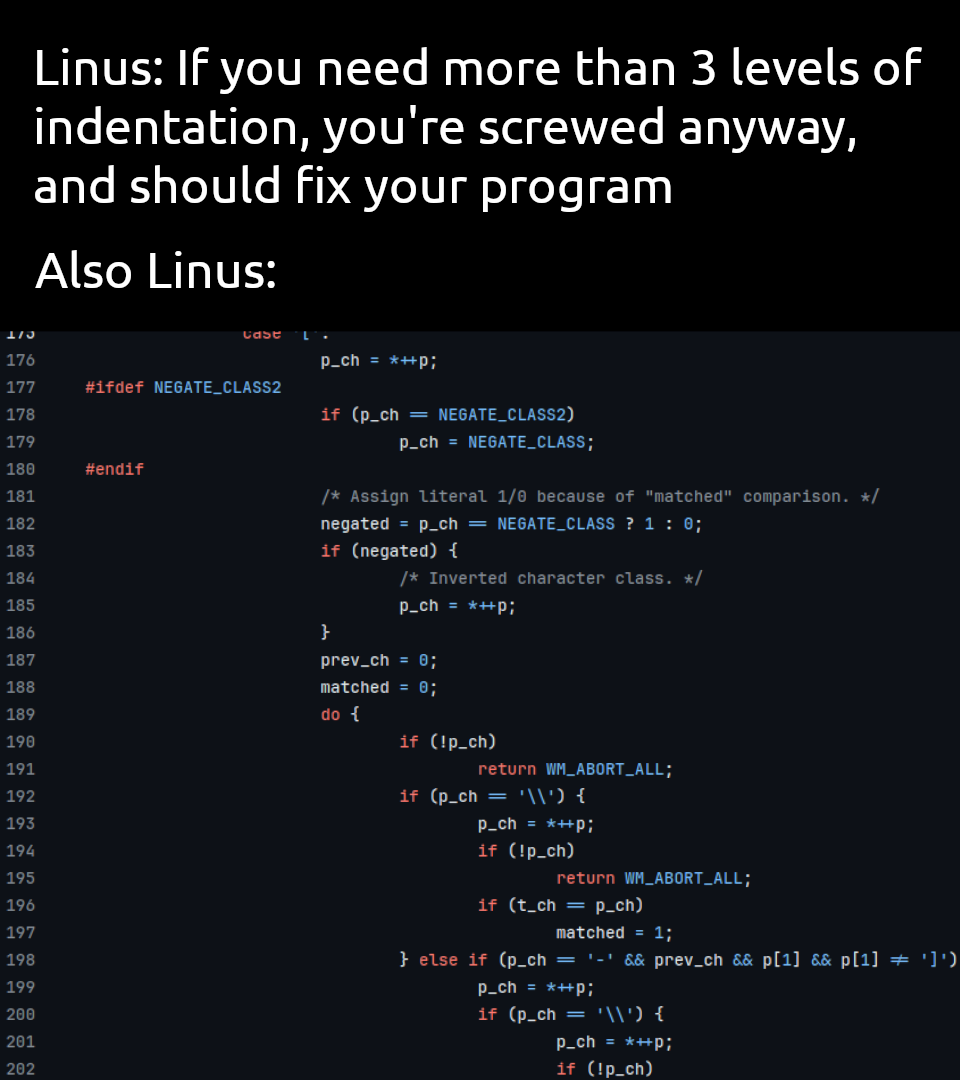this post was submitted on 09 May 2024
458 points (92.4% liked)
Programmer Humor
32580 readers
1031 users here now
Post funny things about programming here! (Or just rant about your favourite programming language.)
Rules:
- Posts must be relevant to programming, programmers, or computer science.
- No NSFW content.
- Jokes must be in good taste. No hate speech, bigotry, etc.
founded 5 years ago
MODERATORS
you are viewing a single comment's thread
view the rest of the comments
view the rest of the comments

Why have an async block spanning the whole function when you can mark the function as async? That's 1 less level of indentation. Also, this quite is unusable for rust. A single match statement inside a function inside an impl is already 4 levels of indentation.
Those async blocks exist when doing async in traits.
And I never said I respected the 4 level of indentations. That's exactly the point of those rules. Keep it lowly indented but still readable
How about this?
I had some luck applying this to
matchstatements. My example:Is this acceptable, at least compared to the original
switchstatement idea?It's a lot less readable imo. As well than a
cargo fmtlater and it's gone (unless there's a nightly setting for it)Formatters are off-topic for this, styles come first, formatters are developed later.
My other reply:
I mean, I use formatters everywhere I can exactly so I don’t have to think about code style. I’ll take a full code base that’s consistent in a style I dislike, over having another subjective debate about which style is prettier or easier to read, any day. So whatever
cargo fmtspits out is exactly what I’ll prefer, regardless of what it looks like, if only for mere consistency.Well, of course you can have few indent levels by just not indenting, I don't think the readability loss is worth it though. If I had give up some indentation, I'd probably not indent the impl {} blocks.
I just got some idea yesterday regarding
implblocks, ready to be my respondent?I had a big
implblock with 4 levels of indentation, so I cut the block, and replacedwith
mod impl_inputlist;and moved theimplblock to a new file, and did not indent anything inside that block.The advantage this has over just not indenting the
implblock in place, is that people will have difficulty distinguishing between what's in the block and what's outside, and that's why theimplwas moved to its own exclusive file, impl_inputlist.rsMaybe I am overstressing indentation. Ss there something wrong with my setup that prevents me from accepting 4-space indentation?
I use:
Editor: Neovide
Font: "FiraCode Nerd Font Mono:h16" (16px fonts are addicintg)
Monitor: 1366x768, 18.5 inch, 10+ years old, frankenstein-ly repaired Samsung monitor.
Distance: I sit at about 40-60 Cm from my monitor.
That leaves me with a 32x99 view of code excluding line numbers and such.
i personally find this a lot less readable than the
switchexample. thecasekeywords at the start of the line quickly signify its meaning, unlike with=>after the pattern. though i dont speak for everybody.How about this one? it more closely mirrors the switch example:
How about this other one? it goes as far as cloning the switch example's indentation:
the problem is that, while skimming the start of each lines, nothing about
'G' | 'g'tells me that its a branch. i need to spend more time parsing it. mind you, this may simply be a problem with rust's syntax, not just ur formatting.